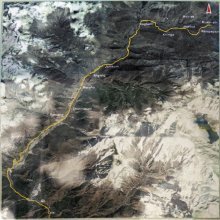Jamuna, Jāmūṇa, Jam̐una°, Jam̐una: 6 definitions
Introduction:
Jamuna means something in Hinduism, Sanskrit, the history of ancient India, Marathi, Jainism, Prakrit, Hindi, biology. If you want to know the exact meaning, history, etymology or English translation of this term then check out the descriptions on this page. Add your comment or reference to a book if you want to contribute to this summary article.
Images (photo gallery)
India history and geography
Source: Shodhganga: A translation of Jhaverchand Meghanis non translated folk talesJamuna refers to “It is the name of one of the largest and holiest rivers known as Yamuna also”.—It is defined in the glossary attached to the study dealing with Gujarat Folk tales composed by Gujarati poet Jhaverchand Meghani (1896-1947)

The history of India traces the identification of countries, villages, towns and other regions of India, as well as mythology, zoology, royal dynasties, rulers, tribes, local festivities and traditions and regional languages. Ancient India enjoyed religious freedom and encourages the path of Dharma, a concept common to Buddhism, Hinduism, and Jainism.
Biology (plants and animals)
Source: Wisdom Library: Local Names of Plants and DrugsJamuna [जमुना] in the Nepali language is the name of a plant identified with Syzygium cumini Syzygium cumini (L.) Skeels from the Myrtaceae (Bottlebrush) family. For the possible medicinal usage of jamuna, you can check this page for potential sources and references, although be aware that any some or none of the side-effects may not be mentioned here, wether they be harmful or beneficial to health.

This sections includes definitions from the five kingdoms of living things: Animals, Plants, Fungi, Protists and Monera. It will include both the official binomial nomenclature (scientific names usually in Latin) as well as regional spellings and variants.
Languages of India and abroad
Marathi-English dictionary
Source: DDSA: The Molesworth Marathi and English Dictionaryjāmūṇa (जामूण) [or न, na].—or na a (vāmana S) Dwarfish, pigmy, short of stature.
Marathi is an Indo-European language having over 70 million native speakers people in (predominantly) Maharashtra India. Marathi, like many other Indo-Aryan languages, evolved from early forms of Prakrit, which itself is a subset of Sanskrit, one of the most ancient languages of the world.
Sanskrit dictionary
Source: Cologne Digital Sanskrit Dictionaries: Monier-Williams Sanskrit-English DictionaryJāmuna (जामुन):—mfn. = yām, [???]
Sanskrit, also spelled संस्कृतम् (saṃskṛtam), is an ancient language of India commonly seen as the grandmother of the Indo-European language family (even English!). Closely allied with Prakrit and Pali, Sanskrit is more exhaustive in both grammar and terms and has the most extensive collection of literature in the world, greatly surpassing its sister-languages Greek and Latin.
Hindi dictionary
Source: DDSA: A practical Hindi-English dictionary1) Jamunā (जमुना):—(nf) the river yamuna:.
2) Jāmuna (जामुन) [Also spelled jamun]:—(nf) jambo, a black plum (the tree and its fruit); ~[nī] of the colour of [jāmuna], bluish black.
...
Prakrit-English dictionary
Source: DDSA: Paia-sadda-mahannavo; a comprehensive Prakrit Hindi dictionaryJaṃuṇa (जंउण) in the Prakrit language is related to the Sanskrit word: Yamunā.
Jaṃuṇa has the following synonyms: Jauṇa.
Prakrit is an ancient language closely associated with both Pali and Sanskrit. Jain literature is often composed in this language or sub-dialects, such as the Agamas and their commentaries which are written in Ardhamagadhi and Maharashtri Prakrit. The earliest extant texts can be dated to as early as the 4th century BCE although core portions might be older.
See also (Relevant definitions)
Starts with: Jamunaa, Jamunadesha, Jamunathapura.
Ends with: Digaramajamuna, Gamgajamuna, Gulaba-jamuna, Gulaphajamuna, Majamuna.
Full-text (+5): Yamuna, Jauna, Jamun, Phalemda, Gulaba-jamuna, Gulaba, Gangajamuni, Gulab-jamun, Jambu, Shashasthali, Samasthala, Gulab, Dvaipayan, Arkatanaya, Jala, Srotonjana, Pancala, Yadu, Jaba, Jab.
Relevant text
Search found 19 books and stories containing Jamuna, Jāmūṇa, Jāmuna, Jamunā, Jaṃuṇa, Jaṃuṇā, Jam̐una, Jam̐uṇā, Jamuṇā, Jam̐una°, Jam̐uṇa°; (plurals include: Jamunas, Jāmūṇas, Jāmunas, Jamunās, Jaṃuṇas, Jaṃuṇās, Jam̐unas, Jam̐uṇās, Jamuṇās, Jam̐una°s, Jam̐uṇa°s). You can also click to the full overview containing English textual excerpts. Below are direct links for the most relevant articles:
Folk Tales of Gujarat (and Jhaverchand Meghani) (by Vandana P. Soni)
Chapter 23 - Gor Gorani Ni Tikhal < [Part 3 - Kankavati]
Beauty-Contest < [Jul–Sept 1971]
Success Unto You TRIVENI! < [April – June, 2004]
Triple Stream < [January – March, 1994]
Chaitanya's Life and Teachings (by Krishna-das Kaviraj)
Chapter I - At the House of Adwaita
Chapter XXVI - The Master's love-sickness for Krishna; His visions and transports of bhakti
Rivers in Ancient India (study) (by Archana Sarma)
11. Descriptions of the rivers in the Jambudvīpa < [Chapter 5 - Rivers in the Purāṇic Literature]
15. The river Lauhitya or Brahmaputra and its present status < [Chapter 6 - Changing trends of the Rivers from Vedic to Purāṇic Age]
Kavyamimamsa of Rajasekhara (Study) (by Debabrata Barai)
Part 17 - Rasagaṅgādhara of Jagannātha < [Chapter 2 - A General Outlines of Sanskrit Poetics]
Part 8.3 - Rājaśekhara’s concepts of Bhāratavarṣa (undivided india) < [Chapter 5 - Analyasis and Interpretations of the Kāvyamīmāṃsā]
Appendix 2 - Identification of Geographical names mentioned in the Kāvyamīmāṃsā
The Garuda Purana (by Manmatha Nath Dutt)
Chapter CXXVI - Visvedeva Puja < [Brihaspati (Nitisara) Samhita]

